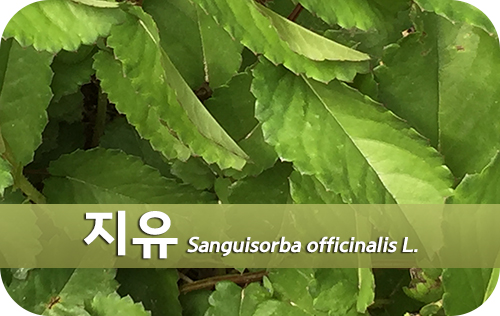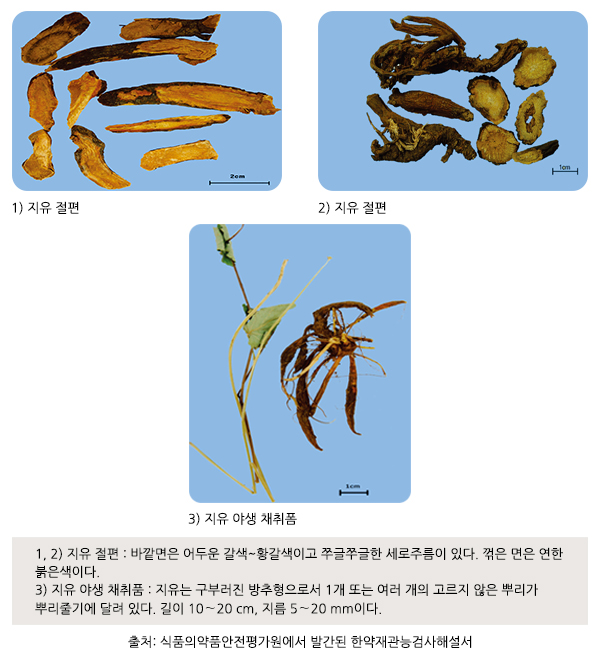지유는 장미과 (Rosaceae) 오이풀속 (Sanguisorba)에 속하는 오이풀 (Sanguisorba officinalis) 또는 장엽지유 (Sanguisorba officinalis L. var. longifolis (Bert.) Yu et Li)의 뿌리입니다. 오이풀속 (지유속)의 식물은 2000년 이상 약용 식물로 사용되었으며, 주로 아시아, 서유럽, 북아메리카 등의 북반구 온대지역에 널리 자생합니다 [1].
전통 및 현대적 사용
지유는 아시아 지역에서 설사, 만성적인 장의 감염 (chronic intestinal infections), 십이지장 궤양 (duodenal ulcer) 및 출혈에 사용된 약재입니다. 특히 지유는 모든 종류의 출혈에 빈번하게 사용됩니다. 지유가 약물로 처음 등장한 것은 <신농본초경>이며, <전남본초 滇南本草>, <일화자본초 日華子本草> 등에도 수록되었습니다 [1].
성분
1. 탄닌 (Tannin)
2. 트리테르페노이드 (Triterpenoid)
3. 기타
지유는 탄닌 성분인 sanguiin H1, H2, H3, H6 및 H11, catechol, gallocatechol 등과 트리테르페노이드 성분인 ursolic acid, benthamic acid, euscaphic acid, pomolic acid, ziyuglycoside I, II 등을 함유하고 있습니다 [1]. 또한 미네랄이 풍부한 것으로 알려져 있습니다 [2].
약리작용
1. 혈액에 대한 작용
1) 지혈 작용 : megakaryopoiesis (거핵구 형성)
2) 조혈 작용
2. 항알레르기 작용
3. 피부보호 작용
4. 항균 작용
5. 항바이러스 작용
6. 항염증 작용
7. 항산화 작용
8. 항암 작용
9. 신경보호 작용
전통적으로 지유는 출혈에 빈번하게 사용되었으며, 이에 대한 약리연구들이 발표되었습니다. 지유의 성분 중 테르펜 배당체 (terpene glycosides)가 지혈 효과를 보였으며, 후속 연구에서 배당체 중 ziyuglycoside I의 성분이 가장 효과적이라고 보고했습니다 [3,4]. 또한 지유의 지혈은 3,3',4-tri-O-methylellagic acid 성분에 의한 것이라는 연구가 1984년 일본에서 보고되었고 [5], 이후 3,3',4-tri-O-methylellagic acid or 3,3',4-tri-O-methylellagic acid-4'-O-β-d-xyloside 성분이 거핵구 형성 (megakaryopoiesis)을 유도하는 것으로 나타났습니다 [6]. 지유의 총 사포닌 역시 거핵구 세포 전구체 (megakaryocyte progenitor)의 증식과 분화를 촉진시켰습니다 [7].
지유는 지혈 작용 이외에 조혈 작용이 있다는 연구가 있습니다. 특히 중국에서는 항암 요법 또는 방사선 치료에 의한 골수 억제에 지유를 사용하고 있어, 조혈 작용에 대한 가능성을 시사합니다. 그러나 조혈에 대한 정확한 기전 및 활성 성분에 대한 연구가 적습니다. 최근 지유의 총 사포닌과 ziyuglycoside I, II 성분이 mouse의 골수 세포의 생존을 개선하는 것으로 나타났습니다. 특히 이들 성분은 조혈을 억제하는 것으로 알려진 MIP2, PF4, P-selectin의 분비를 하향 조절했습니다 [8].
지유는 몇몇 연구에서 항알레르기 작용을 보였습니다. Shin TY 등은 지유 물 추출물의 in vivo, in vitro 연구를 수행했습니다. 추출물은 compound 48/80에 의한 전신 알레르기 반응을 억제했으며, 이는 혈장 히스타민 농도 억제를 동반했습니다. 또한 수동 피부 아나필락시스 (passive cutaneous anaphylaxis; PCA) 역시 용량의존적으로 억제했으며 특히 추출물은 anti-DNP IgE-유도 TNFα 생성을 억제했습니다 [9]. 이후 Park KH 등은 지유에서 추출한 이당류 (disaccharide) 성분이 히스타민 분비 억제를 통해, 항알레르기 작용을 가진다고 하였습니다 (in vivo, in vitro) [10]. Lee NH 등은 OVA-유도 천식 모델 (murine)에서 지유 에탄올 추출물이 염증 세포 침윤을 감소시키며, Th2 사이토카인 및 IgE 농도를 감소시킨다고 보고했습니다 [11]. 또한 아토피 피부염 동물 모델에서 지유 또는 지유 + 황백 (염수초)를 경구 및 국소 적용했을 때 효과적이었습니다 [12,13].
지유는 실험 연구에서 자외선에 의한 색소침착을 억제했으며 [14], 지유 성분인 ziyuglycoside I의 항주름 활성 (Anti-wrinkle activity)도 있었습니다 [15].
지유와 그 성분은 몇몇 암 세포 연구에서 항암 작용을 나타냈습니다. 유방암 세포인 MCF-7, MDA-MB-231 [16,17], MDA-MB-435 [18], 위암 세포 (BGC-823 cells) [19], 구강암 세포 (HSC4, HN22) [20], 전립선암 세포 (PC3) [21]에서 항암 작용을 보였습니다.
임상연구 및 증례보고
지유는 지혈뿐 아니라, 조혈 작용으로 주목받고 있습니다. 실제 중국에서는 백혈구 감소증에 지유 단미를 사용하고 있습니다. Ma LX 등은 2015년 항암 치료에 의한 백혈구 감소증에 대한 중약 치료 체계적 문헌고찰 및 메타 분석을 발표했습니다. 항암 치료를 받는 환자를 대상으로 진행된 83개 RCT 리뷰로, 사용된 중약은 15개의 특허 약품 (patent medicines)과 47개의 가감방이었습니다. 이 중 지유로 구성된 지유승백편 (地榆升白片)에서 백혈구 감소증에 대한 예방 효과가 확인되었습니다. 그러나 리뷰에 포함된 연구 대부분 질이 낮아, 추가 연구가 요구됩니다 [22].
참고문헌
[1] Zhao Z, He X, Zhang Q, Wei X, Huang L, Fang JC, Wang X, Zhao M, Bai Y, Zheng X. Traditional Uses, Chemical Constituents and Biological Activities of Plants from the Genus Sanguisorba L. Am J Chin Med. 2017;45(2):199-224. doi: 10.1142/S0192415X17500136. Epub 2017 Mar 2.
[2] Zhu M, Wong PY, Li RC. Influence of Sanguisorba officinalis, a mineral-rich plant drug, on the pharmacokinetics of ciprofloxacin in the rat. J Antimicrob Chemother. 1999 Jul;44(1):125-8.
[3] Sun W, Zhang ZL, Liu X, Zhang S, He L, Wang Z, Wang GS. Terpene glycosides from the roots of Sanguisorba officinalis L. and their hemostatic activities. Molecules. 2012 Jun 25;17(7):7629-36. doi: 10.3390/molecules17077629.
[4] Sun W, Zhang ZL, Liu X, Zhang S, He L, Wang Z, Wang GS. Terpene glycosides from the roots of Sanguisorba officinalis L. and their hemostatic activities. Molecules. 2012 Jun 25;17(7):7629-36. doi: 10.3390/molecules17077629.
[5] Kosuge T, Ishida H, Yokota M, Yoshida M. Studies on antihemorrhagic substances in herbs classified as hemostatics in Chinese medicine. III. On the antihemorrhagic principle in Sanguisorba officinallis L. Chem Pharm Bull (Tokyo). 1984 Nov;32(11):4478-81.
[6] Gao X, Wu J, Zou W, Dai Y. Two ellagic acids isolated from roots of Sanguisorba officinalis L. promote hematopoietic progenitor cell proliferation and megakaryocyte differentiation. Molecules. 2014 Apr 24;19(4):5448-58. doi: 10.3390/molecules19045448.
[7] Dai YP, Gao XP, Wu JM, Li X, Huang FH, Zou WJ. Effect of total saponins from Sanguisorba officinalis on megakaryocyte progenitor cells proliferation, differentiation and relative receptor expression. Zhongguo Zhong Yao Za Zhi. 2014 May;39(9):1685-9.
[8] Chen X, Li B, Gao Y, Ji J, Wu Z, Chen S. Saponins from Sanguisorba officinalis Improve Hematopoiesis by Promoting Survival through FAK and Erk1/2 Activation and Modulating Cytokine Production in Bone Marrow. Front Pharmacol. 2017 Mar 16;8:130. doi: 10.3389/fphar.2017.00130.
[9] Shin TY, Lee KB, Kim SH. Anti-allergic effects of Sanguisorba officinalis on animal models of allergic reactions. Immunopharmacol Immunotoxicol. 2002 Aug;24(3):455-68.
[10] Park KH, Koh D, Kim K, Park J, Lim Y. Antiallergic activity of a disaccharide isolated from Sanguisorba officinalis. Phytother Res. 2004 Aug;18(8):658-62.
[11] Lee NH, Lee MY, Lee JA, Jung DY, Seo CS, Kim JH, Shin HK. Anti-asthmatic effect of Sanguisorba officinalis L. and potential role of heme oxygenase-1 in an ovalbumin-induced murine asthma model. Int J Mol Med. 2010 Aug;26(2):201-8.
[12] Park S, Kim DS, Kang S, Shin BK. Synergistic topical application of salt-processed Phellodendron amurense and Sanguisorba officinalis Linne alleviates atopic dermatitis symptoms by reducing levels of immunoglobulin E and pro-inflammatory cytokines in NC/Nga mice. Mol Med Rep. 2015 Nov;12(5):7657-64. doi: 10.3892/mmr.2015.4348. Epub 2015 Sep 22.
[13] Yang JH, Yoo JM, Cho WK, Ma JY. Ethanol Extract of Sanguisorbae Radix Inhibits Mast Cell Degranulation and Suppresses 2,4-Dinitrochlorobenzene-Induced Atopic Dermatitis-Like Skin Lesions. Mediators Inflamm. 2016;2016:2947390. doi: 10.1155/2016/2947390. Epub 2016 Mar 15.
[14] Tsukahara K, Moriwaki S, Fujimura T, Takema Y. Inhibitory effect of an extract of Sanguisorba officinalis L. on ultraviolet-B-induced photodamage of rat skin. Biol Pharm Bull. 2001 Sep;24(9):998-1003.
[15] Kim YH, Chung CB, Kim JG, Ko KI, Park SH, Kim JH, Eom SY, Kim YS, Hwang YI, Kim KH. Anti-wrinkle activity of ziyuglycoside I isolated from a Sanguisorba officinalis root extract and its application as a cosmeceutical ingredient. Biosci Biotechnol Biochem. 2008 Feb;72(2):303-11.
[16] Wang Z, Loo WT, Wang N, Chow LW, Wang D, Han F, Zheng X, Chen JP. Effect of Sanguisorba officinalis L on breast cancer growth and angiogenesis. Expert Opin Ther Targets. 2012 Mar;16 Suppl 1:S79-89. doi: 10.1517/14728222.2011.642371.
[17] Zhu X, Wang K, Zhang K, Zhu L, Zhou F. Ziyuglycoside II induces cell cycle arrest and apoptosis through activation of ROS/JNK pathway in human breast cancer cells. Toxicol Lett. 2014 May 16;227(1):65-73. doi: 10.1016/j.toxlet.2014.03.015.
[18] Zhu X, Wang K, Zhang K, Huang B, Zhang J, Zhang Y, Zhu L, Zhou B, Zhou F. Ziyuglycoside II inhibits the growth of human breast carcinoma MDA-MB-435 cells via cell cycle arrest and induction of apoptosis through the mitochondria dependent pathway. Int J Mol Sci. 2013 Sep 3;14(9):18041-55. doi: 10.3390/ijms140918041.
[19] Zhu AK, Zhou H, Xia JZ, Jin HC, Wang K, Yan J, Zuo JB, Zhu X, Shan T. Ziyuglycoside II-induced apoptosis in human gastric carcinoma BGC-823 cells by regulating Bax/Bcl-2 expression and activating caspase-3 pathway. Braz J Med Biol Res. 2013 Aug;46(8):670-5. doi: 10.1590/1414-431X20133050.
[20] Shin JA, Kim JS, Kwon KH, Nam JS, Jung JY, Cho NP, Cho SD. Apoptotic effect of hot water extract of Sanguisorba officinalis L. in human oral cancer cells. Oncol Lett. 2012 Sep;4(3):489-94.
[21] Choi ES, Kim JS, Kwon KH, Kim HS, Cho NP, Cho SD. Methanol extract of Sanguisorba officinalis L. with cytotoxic activity against PC3 human prostate cancer cells. Mol Med Rep. 2012 Sep;6(3):670-4. doi: 10.3892/mmr.2012.949.
[22] Ma LX, Ai P, Li H, Vardy J. The prophylactic use of Chinese herbal medicine for chemotherapy-induced leucopenia in oncology patients: a systematic review and meta-analysis of randomized clinical trials. Support Care Cancer. 2015 Feb;23(2):561-79. doi: 10.1007/s00520-014-2469-8.
© 공병희 원장의 현대적 본초 읽기


